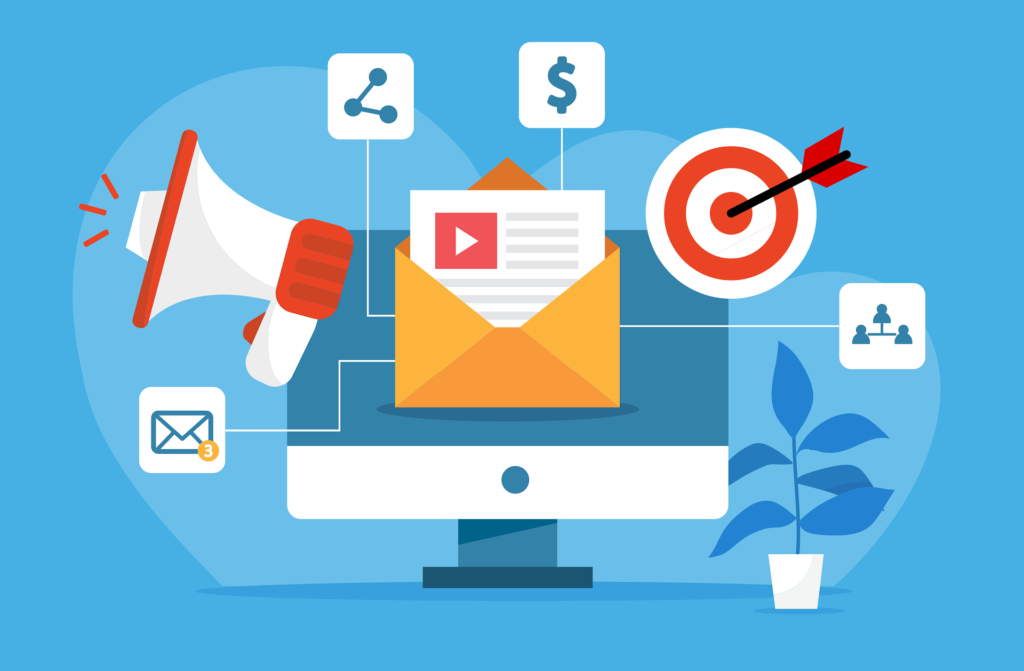What is Email Marketing?
Knowing Email Marketing and how does it work is something mandatory in 2024 for running your business. Email marketing is a form of direct marketing that involves sending emails to a targeted audience to achieve specific business goals. These goals can include promoting products or services, informing customers about news or updates, or nurturing leads through the sales funnel.
Table of Contents

Key Components of Email Marketing
- Email Lists: Building a high-quality email list is crucial. This list comprises subscribers who have opted in to receive communications from your business. List-building strategies include offering valuable content or incentives, like discounts or exclusive offers, in exchange for email addresses.
- Campaigns: Email campaigns are the heart of email marketing. They can be one-time promotions, regular newsletters, or automated sequences. The success of a campaign relies on creating relevant, engaging content that resonates with your audience.
- Segmentation: Segmenting your email list involves dividing your subscribers into smaller groups based on criteria such as behavior, demographics, or purchase history. This allows for more personalized and targeted messaging, which can significantly improve engagement and conversion rates.
- Analytics: Analyzing the performance of your email campaigns is essential for optimizing your strategy. Key metrics include open rates, click-through rates (CTR), conversion rates, and unsubscribe rates. This data helps in refining your approach and achieving better results.

How Does Email Marketing Work?
Email marketing works through a series of strategic steps, from list building to campaign execution and analysis. Here’s a breakdown of how the process typically unfolds:
1. Building and Maintaining an Email List
The foundation of successful email marketing is a well-maintained list of subscribers. To build this list, businesses use various methods:
- Opt-In Forms: Placing sign-up forms on your website or landing pages encourages visitors to subscribe to your emails.
- Lead Magnets: Offering valuable resources, such as eBooks, whitepapers, or discount codes, in exchange for email addresses can boost sign-ups.
- Events and Webinars: Collecting email addresses during events or webinars can help grow your list.
Maintaining the list is equally important. Regularly clean your list to remove inactive or invalid email addresses, and ensure compliance with regulations like GDPR and CAN-SPAM Act.
2. Creating Compelling Content
Content is king in email marketing. Crafting engaging and valuable content involves:
- Subject Lines: The subject line is the first thing recipients see. Make it compelling and relevant to increase open rates.
- Body Content: Provide useful information, offers, or updates. Ensure the content is well-written, visually appealing, and aligned with your brand’s voice.
- Call to Action (CTA): Every email should have a clear CTA that guides recipients on what to do next, whether it’s making a purchase, signing up for an event, or visiting your website.
3. Designing Your Emails
Email design plays a critical role in user engagement. Key design elements include:
- Responsive Design: Ensure your emails are mobile-friendly since a significant portion of email opens occurs on mobile devices.
- Visuals: Use images, videos, and graphics to make your emails more engaging. However, balance visuals with text to avoid emails being marked as spam.
- Layout: A clean, organized layout improves readability and user experience. Use headings, bullet points, and short paragraphs.
Experts are here to give you support.
4. Sending and Automating Emails
The timing and frequency of your emails can impact their effectiveness. Best practices include:
- Scheduling: Choose optimal times to send your emails based on your audience’s behavior. Test different times to find what works best.
- Automation: Email automation allows you to send triggered emails based on specific actions or events, such as welcome emails for new subscribers, abandoned cart reminders, or post-purchase follow-ups. This enhances user experience and increases efficiency.
5. Tracking and Analyzing Results
Analyzing the performance of your email campaigns provides insights into what works and what needs improvement. Key metrics to track include:
- Open Rates: The percentage of recipients who open your emails. A low open rate may indicate that your subject lines need improvement.
- Click-Through Rates (CTR): The percentage of recipients who click on links within your email. High CTRs suggest that your content and CTAs are effective.
- Conversion Rates: The percentage of recipients who complete a desired action, such as making a purchase. This metric helps evaluate the overall success of your campaign.
- Unsubscribe Rates: The percentage of recipients who opt out of receiving future emails. Monitoring this rate helps identify potential issues with your email content or frequency.
6. Testing and Optimization
Continuous testing and optimization are key to improving your email marketing strategy. A/B testing different elements, such as subject lines, content, and CTAs, helps determine what resonates best with your audience. Use insights from these tests to refine your approach and enhance campaign performance.
Benefits of Email Marketing
Email marketing offers numerous advantages, including:
- Cost-Effectiveness: Compared to other marketing channels, email marketing is relatively inexpensive, offering a high return on investment (ROI).
- Direct Communication: Email provides a direct line of communication with your audience, allowing for personalized interactions.
- Scalability: Email marketing campaigns can be scaled to reach small niche segments or large audiences, depending on your goals.
- Measurability: With detailed analytics, you can easily measure the success of your campaigns and make data-driven decisions.
Common Challenges and How to Overcome Them
Despite its advantages, email marketing comes with challenges:
- Spam Filters: Emails may be filtered out by spam filters. To avoid this, ensure your emails comply with best practices and regulations.
- Deliverability Issues: Emails may not always reach the inbox. Maintain a clean list and monitor your sender reputation to improve deliverability.
- Engagement: Maintaining engagement can be challenging. Continuously test and optimize your content to keep your audience interested.
Conclusion
Email marketing remains a dynamic and effective tool for businesses seeking to connect with their audience, drive engagement, and achieve their marketing goals. By understanding the fundamentals of email marketing and implementing best practices, you can harness its full potential and build lasting relationships with your customers.
Whether you’re starting from scratch or refining your current strategy, focusing on building a quality email list, creating compelling content, and analyzing results will set you on the path to success. Embrace the power of email marketing and watch as it transforms your business’s digital presence.
